formerly eScholarship Editions


|
|
|
|
Your request for similar items found 20 book(s). | Modify Search | Displaying 1 - 20 of 20 book(s) | |
| 1. | 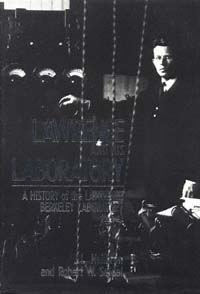 | Title: Lawrence and his laboratory: a history of the Lawrence Berkeley Laboratory Author: Heilbron, J. L Published: University of California Press, 1990 Subjects: Science | History and Philosophy of Science Publisher's Description: The Radiation Laboratory in Berkeley, California, was the birthplace of particle accelerators, radioisotopes, and modern big science. This first volume of its history is a saga of physics and finance in the Great Depression, when a new kind of science was born.Here we learn how Ernest Lawrence used local and national technological, economic, and manpower resources to build the cyclotron, which enabled scientists to produce high-voltage particles without high voltages. The cyclotron brought Lawrence forcibly and permanently to the attention of leaders of international physics in Brussels at the Solvay Congress of 1933. Ever since, the Rad Lab has played a prominent part on the world stage.The book tells of the birth of nuclear chemistry and nuclear medicine in the Laboratory, the discoveries of new isotopes and the transuranic elements, the construction of the ultimate cyclotron, Lawrence's Nobel Prize, and the energy, enthusiasm, and enterprise of Laboratory staff. Two more volumes are planned to carry the story through the Second World War, the establishment of the system of national laboratories, and the loss of Berkeley's dominance of high-energy physics. [brief] Similar Items |
| 2. | 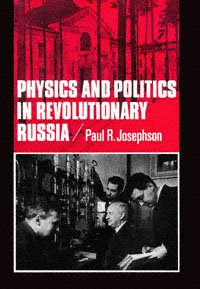 | Title: Physics and politics in revolutionary Russia Author: Josephson, Paul R Published: University of California Press, 1991 Subjects: History | History and Philosophy of Science | Russian and Eastern European Studies | Politics Publisher's Description: Aided by personal documents and institutional archives that were closed for decades, this book recounts the development of physics - or, more aptly, science under stress - in Soviet Russia up to World War II. Focusing on Leningrad, center of Soviet physics until the late 1930s, Josephson discusses the impact of scientific, cultural, and political revolution on physicists' research and professional aspirations.Political and social revolution in Russia threatened to confound the scientific revolution. Physicists eager to investigate new concepts of space, energy, light, and motion were forced to accommodate dialectical materialism and subordinate their interests to those of the state. They ultimately faced Stalinist purges and the shift of physics leadership to Moscow. This account of scientists cut off from their Western colleagues reveals a little-known part of the history of modern physics. [brief] Similar Items |
| 3. | 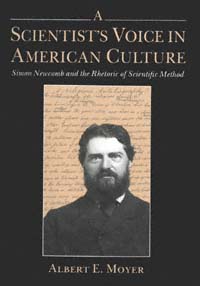 | Title: A scientist's voice in American culture: Simon Newcomb and the rhetoric of scientific method Author: Moyer, Albert E 1945- Published: University of California Press, 1992 Subjects: History | History and Philosophy of Science | United States History Publisher's Description: In late nineteenth-century America, Simon Newcomb was the nation's most celebrated scientist and - irascibly, doggedly, tirelessly - he made the most of it. Officially a mathematical astronomer heading a government agency, Newcomb spent as much of his life out of the observatory as in it, acting as a spokesman for the nascent but restive scientific community of his time.Newcomb saw the "scientific method" as a potential guide for all disciplines and a basis for all practical action, and argued passionately that it was of as much use in the halls of Congress as in the laboratory. In so doing, he not only sparked popular support for American science but also confronted a wide spectrum of social, cultural, and intellectual issues. This first full-length study of Newcomb traces the development of his faith in science and ranges over topics of great public debate in the Gilded Age, from the reform of economic theory to the recasting of the debate between science and religion. Moyer's portrait of a restless, eager mind also illuminates the bustle of late nineteenth-century America. [brief] Similar Items |
| 4. | 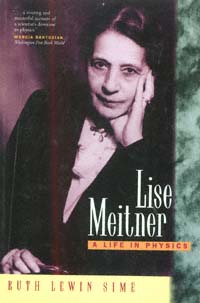 | Title: Lise Meitner: a life in physics Author: Sime, Ruth Lewin 1939- Published: University of California Press, 1997 Subjects: Science | Physics | Autobiographies and Biographies | Women's Studies | History | History and Philosophy of Science Publisher's Description: Lise Meitner (1878-1968) was a pioneer of nuclear physics and co-discoverer, with Otto Hahn and Fritz Strassmann, of nuclear fission. Braving the sexism of the scientific world, she joined the prestigious Kaiser Wilhelm Institute for Chemistry and became a prominent member of the international physics community. Of Jewish origin, Meitner fled Nazi Germany for Stockholm in 1938 and later moved to Cambridge, England. Her career was shattered when she fled Germany, and her scientific reputation was damaged when Hahn took full credit - and the 1944 Nobel Prize - for the work they had done together on nuclear fission. Ruth Sime's absorbing book is the definitive biography of Lise Meitner, the story of a brilliant woman whose extraordinary life illustrates not only the dramatic scientific progress but also the injustice and destruction that have marked the twentieth century. [brief] Similar Items |
| 5. | 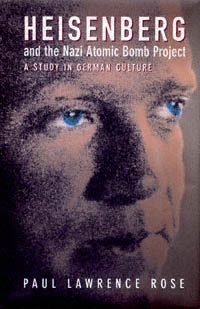 | Title: Heisenberg and the Nazi atomic bomb project: a study in German culture Author: Rose, Paul Lawrence Published: University of California Press, 1998 Subjects: History | European History | German Studies | European Studies | Science | Technology and Society | Physics | History and Philosophy of Science Publisher's Description: No one better represents the plight and the conduct of German intellectuals under Hitler than Werner Heisenberg, whose task it was to build an atomic bomb for Nazi Germany. The controversy surrounding Heisenberg still rages, because of the nature of his work and the regime for which it was undertaken. What precisely did Heisenberg know about the physics of the atomic bomb? How deep was his loyalty to the German government during the Third Reich? Assuming that he had been able to build a bomb, would he have been willing? These questions, the moral and the scientific, are answered by Paul Lawrence Rose with greater accuracy and breadth of documentation than any other historian has yet achieved.Digging deep into the archival record among formerly secret technical reports, Rose establishes that Heisenberg never overcame certain misconceptions about nuclear fission, and as a result the German leaders never pushed for atomic weapons. In fact, Heisenberg never had to face the moral problem of whether he should design a bomb for the Nazi regime. Only when he and his colleagues were interned in England and heard about Hiroshima did Heisenberg realize that his calculations were wrong. He began at once to construct an image of himself as a "pure" scientist who could have built a bomb but chose to work on reactor design instead. This was fiction, as Rose demonstrates: in reality, Heisenberg blindly supported and justified the cause of German victory. The question of why he did, and why he misrepresented himself afterwards, is answered through Rose's subtle analysis of German mentality and the scientists' problems of delusion and self-delusion. This fascinating study is a profound effort to understand one of the twentieth century's great enigmas. [brief] Similar Items |
| 6. | 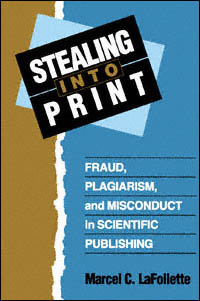 | Title: Stealing into print: fraud, plagiarism, and misconduct in scientific publishing Author: LaFollette, Marcel C. (Marcel Chotkowski) Published: University of California Press, 1992 Subjects: Media Studies | History and Philosophy of Science | Print Media | Public Policy | Science Publisher's Description: False data published by a psychologist influence policies for treating the mentally retarded. A Nobel Prize-winning molecular biologist resigns the presidency of Rockefeller University in the wake of a scandal involving a co-author accused of fabricating data. A university investigating committee declares that almost half the published articles of a promising young radiologist are fraudulent.Incidents like these strike at the heart of the scientific enterprise and shake the confidence of a society accustomed to thinking of scientists as selfless seekers of truth. Marcel LaFollette's long-awaited book gives a penetrating examination of the world of scientific publishing in which such incidents of misconduct take place. Because influential scientific journals have been involved in the controversies, LaFollette focuses on the fragile "peer review" process - the editorial system of seeking pre-publication opinions from experts. She addresses the cultural glorification of science, which, combined with a scientist's thirst for achievement, can seem to make cheating worth the danger. She describes the great risks taken by the accusers - often scholars of less prestige and power than the accused - whom she calls "nemesis figures" for their relentless dedication to uncovering dishonesty.In sober warning, LaFollette notes that impatient calls from Congress, journalists, and taxpayers for greater accountability from scientists have important implications for the entire system of scientific research and communication.Provocative and learned, Stealing Into Print is certain to become the authoritative work on scientific fraud, invaluable to the scientific community, policy makers, and the general public. [brief] Similar Items |
| 7. | 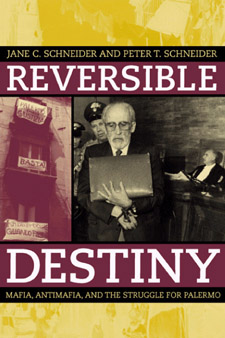 | Title: Reversible destiny: mafia, antimafia, and the struggle for Palermo Author: Schneider, Jane 1938- Published: University of California Press, 2003 Subjects: Anthropology | History | Politics | Criminology | Sociology Publisher's Description: Reversible Destiny traces the history of the Sicilian mafia to its nineteenth-century roots and examines its late twentieth-century involvement in urban real estate and construction as well as drugs. Based on research in the regional capital of Palermo, this book suggests lessons regarding secretive organized crime: its capacity to reproduce a subculture of violence through time, its acquisition of a dense connective web of political and financial protectors during the Cold War era, and the sad reality that repressing it easily risks harming vulnerable people and communities. Charting the efforts of both the judiciary and a citizen's social movement to reverse the mafia's economic, political, and cultural power, the authors establish a framework for understanding both the difficulties and the accomplishments of Sicily's multifaceted antimafia efforts. [brief] Similar Items |
| 8. | 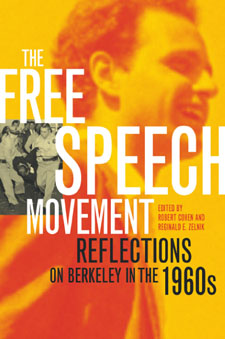 | Title: The Free Speech Movement: reflections on Berkeley in the 1960s Author: Cohen, Robert 1955 May. 21- Published: University of California Press, 2002 Subjects: American Studies | Politics | Sociology | Gender Studies | United States History | Education Publisher's Description: This is the authoritative and long-awaited volume on Berkeley's celebrated Free Speech Movement (FSM) of 1964. Drawing from the experiences of many movement veterans, this collection of scholarly articles and personal memoirs illuminates in fresh ways one of the most important events in the recent history of American higher education. The contributors - whose perspectives range from that of FSM leader Mario Savio to University of California president Clark Kerr - -shed new light on such issues as the origins of the FSM in the civil rights movement, the political tensions within the FSM, the day-to-day dynamics of the protest movement, the role of the Berkeley faculty and its various factions, the 1965 trial of the arrested students, and the virtually unknown "little Free Speech Movement of 1966." [brief] Similar Items |
| 9. | 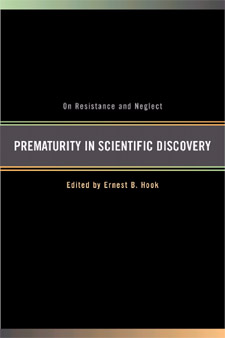 | Title: Prematurity in scientific discovery: on resistance and neglect Author: Hook, Ernest B 1936- Published: University of California Press, 2002 Subjects: Science | History of Science | Social and Political Thought | Geology | Evolution | Physics | History of Medicine Publisher's Description: For centuries, observers have noted the many obstacles to intellectual change in science. In a much-discussed paper published in Scientific American in 1972, molecular biologist Gunther Stent proposed an explicit criterion for one kind of obstacle to scientific discovery. He denoted a claim or hypothesis as "premature" if its implications cannot be connected to canonical knowledge by a simple series of logical steps. Further, Stent suggested that it was appropriate for the scientific community to ignore such hypotheses so that it would not be overwhelmed by vast numbers of false leads. In this volume, eminent scientists, physicians, historians, social scientists, and philosophers respond to Stent's thesis. [brief] Similar Items |
| 10. | 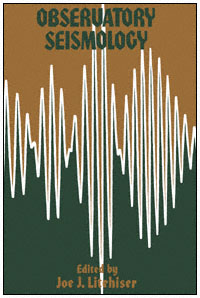 | Title: Observatory seismology: an anniversary symposium on the occasion of the centennial of the University of California at Berkeley seismographic stations Author: Litehiser, J. J. (Joe J.) Published: University of California Press, 1990 Subjects: Science | Geology Publisher's Description: The first effective seismographs were built between 1879 and 1890. In 1885, E. S. Holden, an astronomer and then president of the University of California, instigated the purchase of the best available instruments of the time "to keep a register of all earthquake shocks in order to be able to control the positions of astronomical instruments." These seismographs were installed two years later at Lick Observatory on Mt. Hamilton and at the Berkeley campus of the University. Over the years those stations have been upgraded and joined by other seismographic stations administered at Berkeley, to become the oldest continuously operating stations in the Western Hemisphere. The first hundred years of the Seismographic Stations of the University of California at Berkeley, years in which seismology has often assumed an unforeseen role in issues of societal and political importance, ended in 1987.To celebrate the centennial a distinguished group of fellows, staff, and friends of the Stations met on the Berkeley campus in May 1987. The papers they presented are gathered in this book, a distillation of the current state of the art in observatory seismology. Ranging through subjects of past, present, and future seismological interest, they provide a benchmark reference for years to come. [brief] Similar Items |
| 11. | 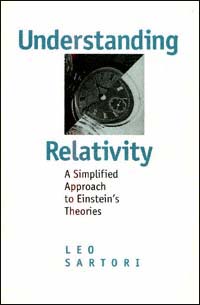 | Title: Understanding relativity: a simplified approach to Einstein's theories Author: Sartori, Leo Published: University of California Press, 1996 Subjects: Science | Physics | History and Philosophy of Science Publisher's Description: Nonspecialists with no prior knowledge of physics and only reasonable proficiency with algebra can now understand Einstein's special theory of relativity. Effectively diagrammed and with an emphasis on logical structure, Leo Sartori's rigorous but simple presentation will guide interested readers through concepts of relative time and relative space.Sartori covers general relativity and cosmology, but focuses on Einstein's theory. He tracks its history and implications. He explores illuminating paradoxes, including the famous twin paradox, the "pole-in-the-barn" paradox, and the Loedel diagram, which is an accessible, graphic approach to relativity. Students of the history and philosophy of science will welcome this concise introduction to the central concept of modern physics. [brief] Similar Items |
| 12. | 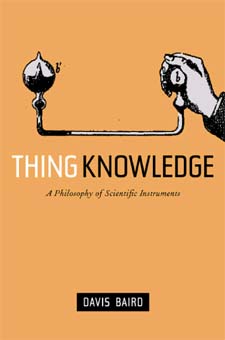 | Title: Thing knowledge: a philosophy of scientific instruments Author: Baird, Davis Published: University of California Press, 2004 Subjects: Philosophy | Technology and Society Publisher's Description: Western philosophers have traditionally concentrated on theory as the means for expressing knowledge about a variety of phenomena. This absorbing book challenges this fundamental notion by showing how objects themselves, specifically scientific instruments, can express knowledge. As he considers numerous intriguing examples, Davis Baird gives us the tools to "read" the material products of science and technology and to understand their place in culture. Making a provocative and original challenge to our conception of knowledge itself, Thing Knowledge demands that we take a new look at theories of science and technology, knowledge, progress, and change. Baird considers a wide range of instruments, including Faraday's first electric motor, eighteenth-century mechanical models of the solar system, the cyclotron, various instruments developed by analytical chemists between 1930 and 1960, spectrometers, and more. [brief] Similar Items |
| 13. | 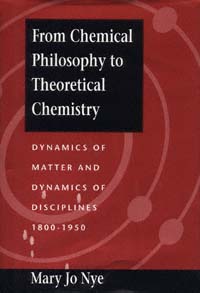 | Title: From chemical philosophy to theoretical chemistry: dynamics of matter and dynamics of disciplines, 1800-1950 Author: Nye, Mary Jo Published: University of California Press, 1994 Subjects: Science | History and Philosophy of Science | Physical Sciences | Physics Publisher's Description: How did chemistry and physics acquire their separate identities, and are they on their way to losing them again? Mary Jo Nye has written a graceful account of the historical demarcation of chemistry from physics and subsequent reconvergences of the two, from Lavoisier and Dalton in the late eighteenth century to Robinson, Ingold, and Pauling in the mid-twentieth century.Using the notion of a disciplinary "identity" analogous to ethnic or national identity, Nye develops a theory of the nature of disciplinary structure and change. She discusses the distinctive character of chemical language and theories and the role of national styles and traditions in building a scientific discipline. Anyone interested in the history of scientific thought will enjoy pondering with her the question of whether chemists of the mid-twentieth century suspected chemical explanation had been reduced to physical laws, just as Newtonian mechanical philosophers had envisioned in the eighteenth century. [brief] Similar Items |
| 14. | 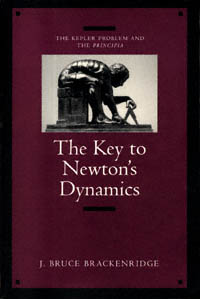 | Title: The key to Newton's dynamics: the Kepler problem and the Principia: containing an English translation of sections 1, 2, and 3 of book one from the first (1687) edition of Newton's Mathematical principles of natural philosophy Author: Brackenridge, J. Bruce 1927- Published: University of California Press, 1996 Subjects: Science | Physics | History and Philosophy of Science Publisher's Description: While much has been written on the ramifications of Newton's dynamics, until now the details of Newton's solution were available only to the physics expert. The Key to Newton's Dynamics clearly explains the surprisingly simple analytical structure that underlies the determination of the force necessary to maintain ideal planetary motion. J. Bruce Brackenridge sets the problem in historical and conceptual perspective, showing the physicist's debt to the works of both Descartes and Galileo. He tracks Newton's work on the Kepler problem from its early stages at Cambridge before 1669, through the revival of his interest ten years later, to its fruition in the first three sections of the first edition of the Principia . [brief] Similar Items |
| 15. | 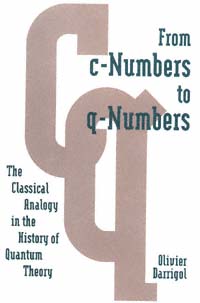 | Title: From c-numbers to q-numbers: the classical analogy in the history of quantum theory Author: Darrigol, Olivier Published: University of California Press, 1993 Subjects: History | History and Philosophy of Science | Physics Publisher's Description: The history of quantum theory is a maze of conceptual problems, through which Olivier Darrigol provides a lucid and learned guide, tracking the role of formal analogies between classical and quantum theory. From Planck's first introduction of the quantum of action to Dirac's formulation of quantum mechanics, Darrigol illuminates not only the history of quantum theory but also the role of analogies in scientific thinking and theory change.Unlike previous works, which have tended to focus on qualitative, global arguments, Darrigol's study follows the lines of mathematical reasoning and symbolizing and so is able to show the motivations of early quantum theorists more precisely - and provocatively - than ever before. Erudite and original, From c-Numbers to q-Numbers sets a new standard as a philosophically perceptive and mathematically precise history of quantum mechanics. For years to come it will influence historical and philosophical discussions of twentieth-century physics. [brief] Similar Items |
| 16. | 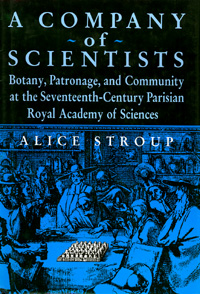 | Title: A company of scientists: botany, patronage, and community at the Seventeenth-century Parisian Royal Academy of Sciences Author: Stroup, Alice Published: University of California Press, 1990 Subjects: History | History and Philosophy of Science | European History Publisher's Description: Who pays for science, and who profits? Historians of science and of France will discover that those were burning questions no less in the seventeenth century than they are today. Alice Stroup takes a new look at one of the earliest and most influential scientific societies, the Académie Royale des Sciences. Blending externalist and internalist approaches, Stroup portrays the Academy in its political and intellectual contexts and also takes us behind the scenes, into the laboratory and into the meetings of a lively, contentious group of investigators.Founded in 1666 under Louis XIV, the Academy had a dual mission: to advance science and to glorify its patron. Creature of the ancien régime as well as of the scientific revolution, it depended for its professional prestige on the goodwill of monarch and ministers. One of the Academy's most ambitious projects was its illustrated encyclopedia of plants. While this work proceeded along old-fashioned descriptive lines, academicians were simultaneously adopting analogical reasoning to investigate the new anatomy and physiology of plants. Efforts to fund and forward competing lines of research were as strenuous then as now. We learn how academicians won or lost favor, and what happened when their research went wrong. Patrons and members shared in a new and different kind of enterprise that may not have resembled the Big Science of today but was nevertheless a genuine "company of scientists." [brief] Similar Items |
| 17. | 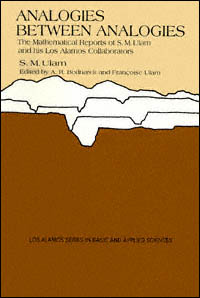 | Title: Analogies between analogies: the mathematical reports of S.M. Ulam and his Los Alamos collaborators Author: Ulam, Stanislaw M Published: University of California Press, 1990 Subjects: Science | Mathematics | Physical Sciences Similar Items |
| 18. | 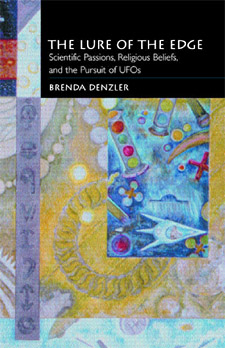 | Title: The lure of the edge: scientific passions, religious beliefs, and the pursuit of UFOs Author: Denzler, Brenda 1953- Published: University of California Press, 2001 Subjects: Religion | Science | Sociology Publisher's Description: UFO phenomena entered American consciousness at the beginning of the Cold War, when reports from astonished witnesses of encounters with unknown aerial objects captured the attention of the United States military and the imagination of the press and the public. But when UFOs appeared not to be hostile, and when some scientists pronounced the sightings to be of natural meteorological phenomena misidentified due to "Cold War jitters," military interest declined sharply and, with it, further overt scientific interest. Yet sighting reports didn't stop and UFOs entered the public imagination as a cultural myth of the twentieth century. Brenda Denzler's comprehensive, clearly written, and compelling narrative provides the first sustained overview and valuation of the UFO/alien abduction movement as a social phenomenon positioned between scientific and religious perspectives. Demonstrating the unique place ufology occupies in the twentieth-century nexus between science and religion, Denzler surveys the sociological contours of its community, assesses its persistent attempt to achieve scientific legitimacy, and concludes with an examination of the movement's metaphysical or spiritual outlook. Her book is a substantial contribution to our understanding of American popular culture and the boundaries of American religion and to the debate about the nature of science and religion. Denzler presents a thorough and fascinating history of the UFO/abduction movement and traces the tensions between those who are deeply ambivalent about abduction narratives that seemingly erode their quest for scientific credibility, and the growing cultural power of those who claim to have been abducted. She locates the phenomenon within the context of American religious history and, using data gathered in surveys, sheds new light on the social profile of these UFO communities. The Lure of the Edge succeeds brilliantly in repositioning a cultural phenomenon considered by many to be bizarre and marginal into a central debate about the nature of science, technology, and the production of a modern myth. [brief] Similar Items |
| 19. | 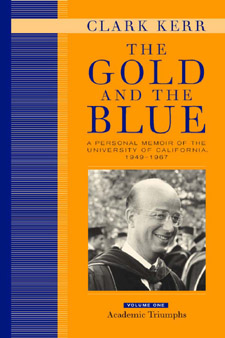 | Title: The gold and the blue: a personal memoir of the University of California, 1949-1967 Author: Kerr, Clark 1911- Published: University of California Press, 2001 Subjects: History | California and the West | Intellectual History | Californian and Western History | Autobiography Publisher's Description: One of the last century's most influential figures in higher education, Clark Kerr was a leading visionary, architect, leader, and fighter for the University of California. Chancellor of the Berkeley campus from 1952 to 1958 and president of the university from 1958 to 1967, Kerr saw the university through its golden years--a time of both great advancement and great conflict. This absorbing memoir is an intriguing insider's account of how the University of California rose to the peak of scientific and scholarly stature and how, under Kerr's unique leadership, the university evolved into the institution it is today. In this first of two volumes, Kerr describes the private life of the university from his first visit to Berkeley as a graduate student at Stanford in 1932 to his dismissal under Governor Ronald Reagan in 1967. Early in his tenure as a professor, the Loyalty Oath issue erupted, and the university, particularly the Berkeley campus, underwent its most difficult upheaval until the onset of the Free Speech Movement in 1964. Kerr discusses many pivotal developments, including the impact of the GI Bill and the evolution of the much-emulated 1960 California Master Plan for Higher Education. He also discusses the movement for universal access to education and describes the establishment and growth of each of the nine campuses and the forces and visions that shaped their distinctive identities. Kerr's perspective of more than fifty years puts him in a unique position to assess which of the academic, structural, and student life innovations of the 1950s and 1960s have proven successful and to consider what lessons about higher education we might learn from that period. The second volume of the memoir will treat the public life of the university and the political context that conditioned its environment. [brief] Similar Items |
| 20. | 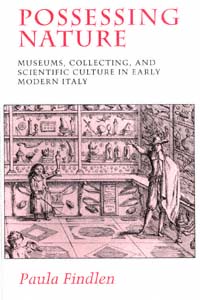 | Title: Possessing nature: museums, collecting, and scientific culture in early modern Italy Author: Findlen, Paula Published: University of California Press, 1994 Subjects: History | History and Philosophy of Science | European History | Renaissance History Publisher's Description: In 1500 few Europeans regarded nature as a subject worthy of inquiry. Yet fifty years later the first museums of natural history had appeared in Italy, dedicated to the marvels of nature. Italian patricians, their curiosity fueled by new voyages of exploration and the humanist rediscovery of nature, created vast collections as a means of knowing the world and used this knowledge to their greater glory.Drawing on extensive archives of visitors' books, letters, travel journals, memoirs, and pleas for patronage, Paula Findlen reconstructs the lost social world of Renaissance and Baroque museums. She follows the new study of natural history as it moved out of the universities and into sixteenth- and seventeenth-century scientific societies, religious orders, and princely courts. Findlen argues convincingly that natural history as a discipline blurred the border between the ancients and the moderns, between collecting in order to recover ancient wisdom and the development of new textual and experimental scholarship. Her vivid account reveals how the scientific revolution grew from the constant mediation between the old forms of knowledge and the new. [brief] Similar Items |